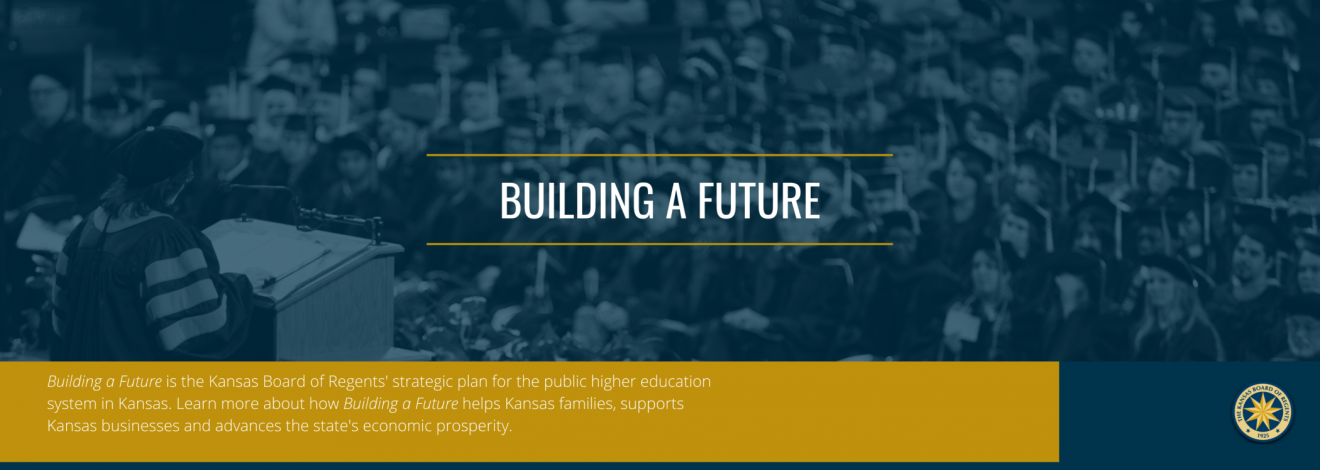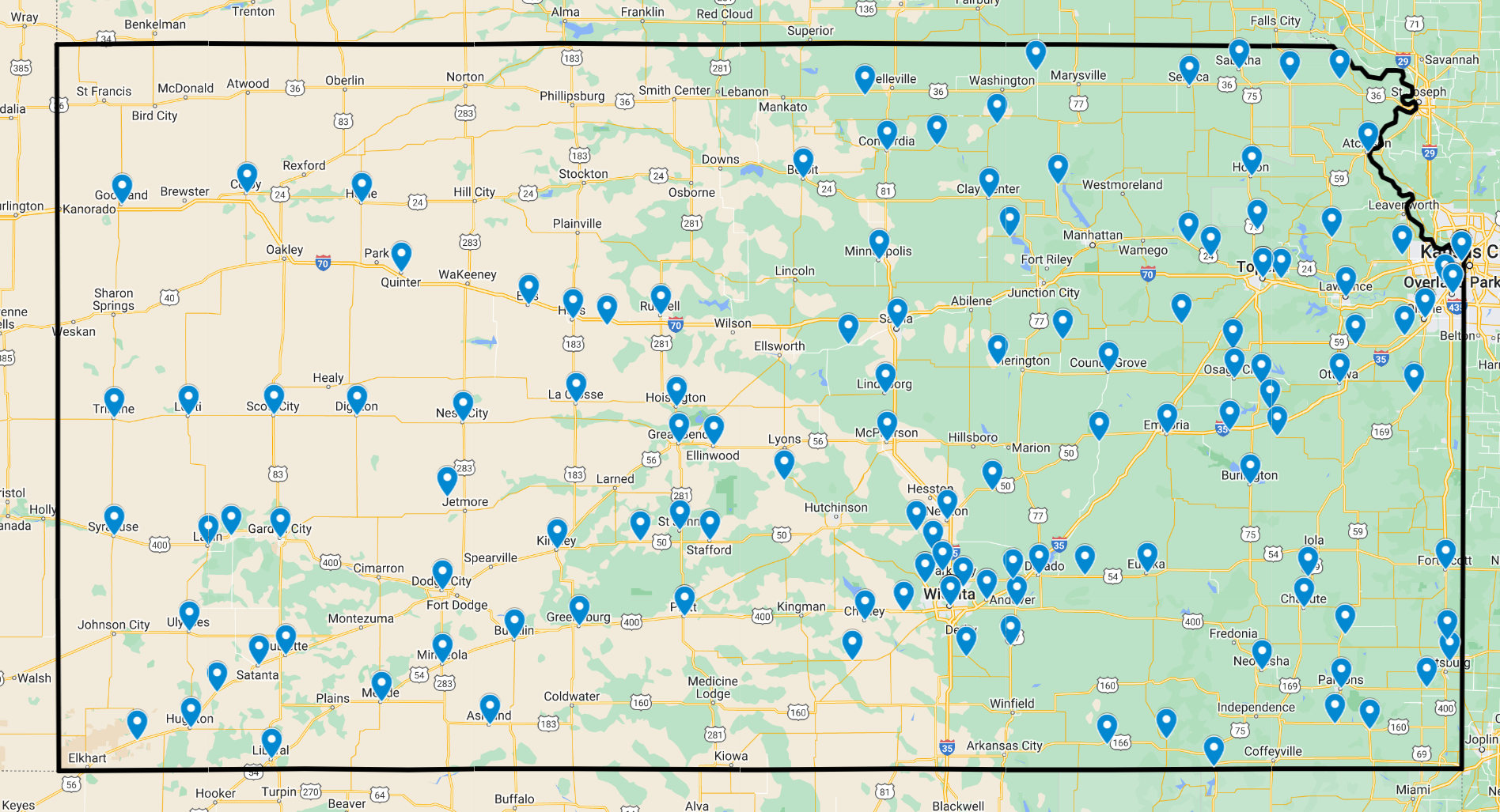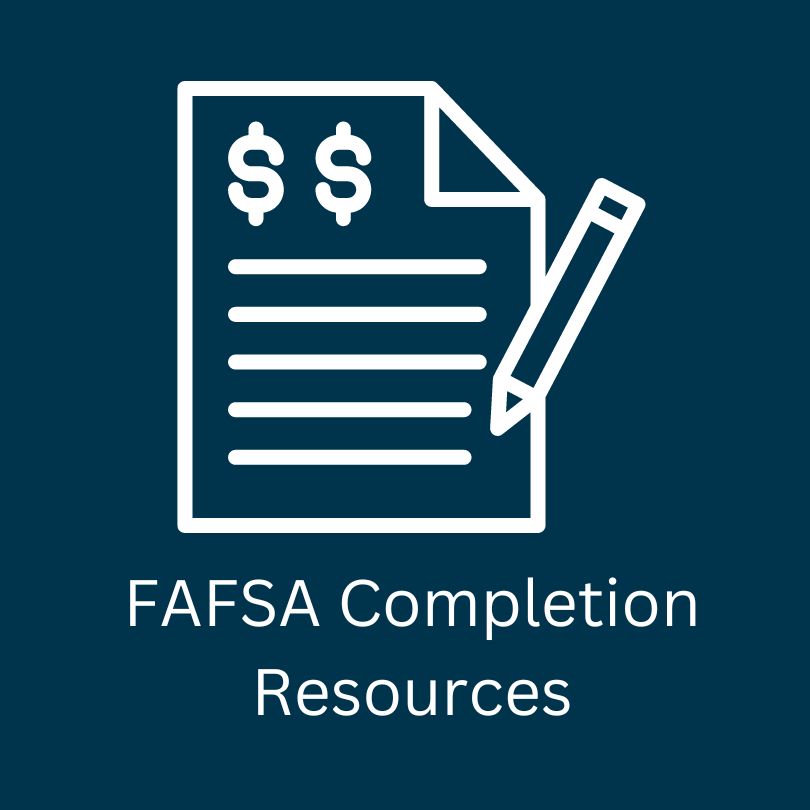1. How many credit hours are required to complete the systemwide GE?
34-35 credit hours are required, and the variation will be based on the natural and physical sciences bucket. Some institutions will require a four-credit course to complete the natural and physical sciences bucket while others will require a five-credit hour course to complete the natural and physical sciences bucket. It is understood that most students will likely require 35-credit hours because most institutions employ five-credit hour general education science courses.
2. What does it mean when a discipline bucket requirement states it requires at least two courses from two subject areas?
This simply means that the student must take at least two courses that are in two different subjects. For example, a student could not satisfy the social and behavioral sciences bucket by taking one three-credit-hour psychology course and a second three-credit-hour psychology course. Conversely, a three-credit-hour psychology course and a three-credit-hour geography course would complete the social and behavioral sciences bucket because it includes two courses from two different subjects.
3. Is an institution required to include performance courses (piano, dance technique, acting, theater lighting, etc.) in its arts and humanities bucket?
No, this is at the discretion of the institution; however, please note that institutions are required to accept this bucket – even when performance courses were taken – as being completed when a transfer student provides an official transcript stating “Systemwide GE Completed.”
4. Are institutions only limited to Systemwide Transfer courses when designing GE requirements?
No. Institutions can also use non-systemwide GE courses that it determines fit under the applicable GE discipline bucket.
5. Are History courses always required under the arts and humanities bucket?
The application of history courses that do not have a specific title emphasizing ethnicity or gender should fall under the arts and humanities bucket to ensure consistency and continuity in the transfer process. As such:
- history courses such as US History to 1877, US History since 1877, World History to 1500, and World History 1500 to Present should fall under the arts and humanities bucket; and
- history courses that focus on a specific ethnicity or gender (e.g., African American History) may fall under the arts and humanities bucket or the social and behavioral sciences bucket.
6. If a student completes a course that could count in both the social and behavioral sciences bucket and the institutionally designated bucket, can the course count in both buckets? For example, if the institution has a diversity requirement in the institutionally designated bucket and the student takes an ethnic and/or gender studies course (which falls under the social and behavioral science bucket), can it count in both the social and behavioral sciences bucket and the institutionally designated bucket?
There is nothing in the policy that explicitly addresses this particular scenario; thus, this is at the discretion of the institution. It should be noted that if one course is counted toward completing requirements in one disciplined-based bucket and the institutionally designated bucket, the student cannot complete the systemwide GE with less than 34 credit hours. Therefore, when one course is double dipped in a disciplined-based bucket and the institutionally designated bucket, additional credit hours will need to be substituted and applied to ensure that the student has a total of at least 34 credit hours to complete the systemwide GE.
7. An institution wishes for some programs to be exempted from certain GE requirements. What information should be known ahead of time on this type of request and what is required to make this type of request?
It should be noted that most states that have a systemwide GE do not provide this type of option, as they mandate that all programs – regardless of accreditation or licensure requirements – redesign their GE requirements to 100% align with the systemwide GE. The few states that have opened a narrow path for institutions to request to deviate from the systemwide GE have been very conservative by granting a small number of such requests. Knowing this coupled with the fact that Kansas has committed to becoming a leading state in reducing barriers for transfer students and creating common paths to completion, these requests will be reviewed under high scrutiny and should be limited to an extremely small percentage of an institution’s overall programs. Background information on this process is detailed below:
|
Request for a Specific Major to Deviate from the Systemwide GE |
|||
|
Scenario: An institution wishes for a specific major to include GE requirements that deviate from the systemwide GE requirements. Who is Impacted: Both native and transfer students |
|||
|
Step One |
Step Two |
Step Three |
Step Four |
|
Institution Identifies Major and Areas It Wishes to Modify |
Institution Completes and Submits Request |
GE Council Reviews and Issues Recommendation |
KBOR Reviews and Issues a Response |
|
The institution identifies a major in which it wishes to deviate from the systemwide GE requirements.
|
The institution will complete and submit an online request to deviate from the systemwide GE.
The criteria for this request are detailed in Chapter III.A.18.c.
|
The GE Council will review and issue a recommendation to approve or deny this request.
|
The Board President and CEO will review the request and recommendation from the GE Council and issue a response to the institution.
|
|
Specific Example That Could Trigger a Request |
|
A major wishes to eliminate the communications bucket because of a programmatic accreditation requirement, and, in turn, only require 31-32 total credit hours to complete the GE. |
8. An institution has a program that requires all its native majors to take a specific course in a GE discipline bucket. When a transfer student has not completed such a specific course before transferring and the institution does not wish to waive such a GE course requirement – even when the transfer student completed the systemwide GE or completed the discipline bucket requirement through systemwide transfer coursework – what is required?
|
Request to Continue Requiring – and not waive – a Specific GE Course Requirement for Transfer Students in a Specific Major |
||
|
Scenario: If an institution wishes for all transfer students in a major to complete a GE course in a specific discipline bucket – even when the transfer student completed the systemwide GE or the applicable discipline bucket requirement through systemwide transfer coursework – it shall submit a request as detailed below. Who is Impacted: Transfer students |
||
|
Step One |
Step Two |
Step Three |
|
Institution Identifies Major and Course |
Institution Completes and Submits Request |
KBOR Reviews and Issues a Response |
|
The institution identifies a major, all majors under a college, or all majors under a degree in which it wishes to not waive a specific course requirement that is classified in its GE when:
a) a transfer student did not complete such a specific course prior to transferring; and
b) a transfer student has completed the Systemwide GE OR completed the discipline bucket requirement through systemwide transfer coursework. |
The institution will complete and submit an online request form to continue requiring – and not waive – the specific GE course requirement for transfer students.
The criteria for this request are detailed in Chapter III.A.2.g.v.
|
The Board President and CEO will review the request and issue a response to the institution.
Note: Per the policy, after initial review, additional information on how such a requirement would financially impact transfer students may also be required.
|
|
Specific Example That Could Trigger a Request |
|
A chemistry program requires all native majors to take chemistry I and lab for majors in the natural and physical sciences bucket. When a transfer student has not completed such a course before transferring, it does not wish to waive such a course requirement – even when the transfer student completed the science bucket or completed the systemwide GE. |
Note: Bucket 3 (the math and statistics bucket) will be defined by the various programs and will not require any exceptions during the inaugural year of systemwide GE in 2024-2025. This is because the system is in transition. It did not make sense to include the math and statistics bucket for exceptions in 2024-2025 knowing that the math pathways work will define this bucket shortly thereafter. It is anticipated that the math pathway requirements will take full effect in either 2025-2026 or 2026-2027. Additional guidance regarding a timeline will be addressed later.
Bucket 7 (the institutionally designated bucket) is not included because this is an institutional requirement that is general rather than a program requirement. It was noted during the GE work that there are certain courses, discipline areas, or focus areas that are not addressed in the framework such as college orientation and/or student success, computer science, agriculture, health and wellness, personal finance, and diversity. There was a desire to have some flexibility to include these types of courses as requirements before certifying a completed GE. Thus, this area was created to provide that type of flexibility. It was not intended to be a program bucket in which each program establishes its own specialized requirements. In the end, this should be designed in such a way that transfer students who completed the systemwide GE at institution A are not required to go back and take any courses from this bucket at institution B.
9. Is the institutionally designated bucket designed for institutions to break away from the GE framework structure and start creating program requirements for each major?
No. It was noted during the GE work that there are certain courses, discipline areas, or focus areas that are not addressed in the framework such as college orientation and/or student success, computer science, agriculture, health and wellness, personal finance, and diversity. There was a desire to have some flexibility to include these types of courses as requirements before certifying a completed GE. Thus, this area was created to provide that type of flexibility. It was not intended to be a program bucket in which each program establishes its own specialized requirements. In the end, this should be designed in such a way that transfer students who completed the systemwide GE at institution A are not required to go back and take any courses from this bucket at institution B.
10. If a program wants to require a course that was previously listed in the general education portion of the degree, can it include it in the major portion of the degree?
Yes, so long as it is required for both native students and transfer students and it is listed in the major portion of the degree (outside the 34-35 credit hour GE framework).
11. Is an institution prohibited from offering a program-specific or institution-specific English/writing course in the GE?
No, but certain provisions must be met when requiring this type of course for transfer students. An institution is not permitted to require transfer students who completed the systemwide GE or did not complete the systemwide GE but earned an acceptable grade in English Composition I and II to take such a course unless it: 1 2
- has been approved by the Board President and CEO to continue requiring – and not waive – such a course; OR
- meets the following:
- requires it’s native and transfer students to take English Composition I and II in the GE portion of the degree;
- lists the program-specific or institution-specific English/writing course under a non-GE portion of the degree that is separate from the GE-based English Composition I and II GE course requirements; and
- complies with the first two sub-bullets above without adding any time to degree for native and transfer students.
12. Is an institution able to change or modify the bucket names?
Common terminology and consistent themes help prospective students, current students, transfer students, academic advisors, and high school counselors connect the dots between multiple institutions. Thus, universal bucket names are a necessary component to provide an avenue to navigate GE requirements throughout the system. The six discipline bucket names identified in the seven-bucket framework should be used by all institutions and each institution can issue a name for the seventh bucket, which is the institutionally designated area bucket.
13. Are the materials from the November 21 and December 20 webinar available?
Yes.
November 21: General Education Webinar Q&A
November 21: General Education Presentation
January 20: General Education Webinar Q&A
January 20: General Education Webinar Presentation
January 20: General Education Video Recording
January 31: General Education Presentation to BAASC
14. When is the date in which the new systemwide GE will take effect at every public community college and university in the state?
At the latest, this will need to take effect on each campus for first-time students and transfer students who begin in the Fall of 2024. As such, when incoming students are enrolled for the Fall 2024 semester beginning in February or March 2024, they will be advised under the new Systemwide GE.
15. Can institutions implement the new GE earlier than Fall 2024?
Yes, nothing prohibits institutions from implementing early.
16. If a student completes the systemwide GE before Fall 2024 and transfers with a statement noting “systemwide GE completed,” is the receiving institution required to accept it and consider the GE completed?
While these will be rare, the answer is yes. The student should not be penalized for completing the systemwide GE at an institution that adopted it early and subsequently transferring to an institution that adopted it later.
17. Is the new systemwide GE retroactive?
All institutions will list the systemwide GE in all degree programs for the 2024-2025 year. Institutions are encouraged to use the new systemwide GE for students who began prior to Fall 2024 if it is beneficial for on-time completion.
18. If a student starts in Fall 2023 at a community college and expresses that they plan to transfer to a university in Fall 2024, how should this student be advised?
The Systemwide Transfer Courses by GE Bucket Resource (this is a list of Systemwide Transfer courses that fall within each respective systemwide discipline bucket) will serve as a valuable advising resource both in the pre and post-stages of GE implementation.
Additionally, if the student has identified the transfer destination, the student should also contact that specific university to learn more.
1 It is understood that a minimum grade may be required for selective admission purposes, programmatic accreditation, or licensure standards.
2 An acceptable grade means that the credit shall not be denied by a receiving Kansas public institution based on a grading standard when a transfer student earns a “C” (2.0) or higher. The receiving Kansas public institution may apply a “D” (1.0) if it is also acceptable for its native students (the application of a “D” must apply equally to both resident and native students).
The systemwide GE program framework is below and is comprised of 34-35 credit hours organized in six discipline-based “buckets” and an institutionally designated bucket. A student who satisfies all seven buckets will complete the systemwide GE program. Additionally, here is a printable version of the GE framework.
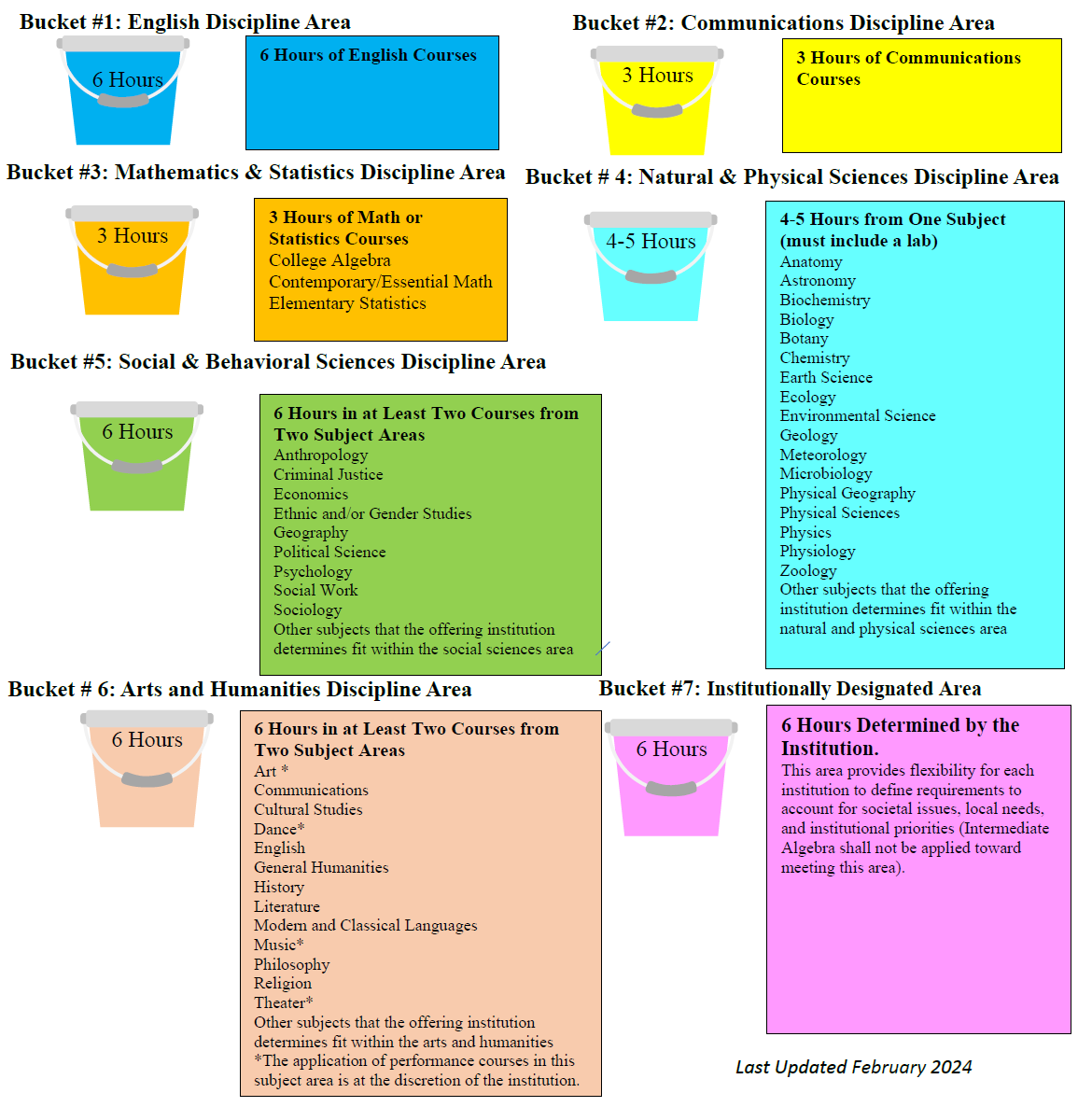
General Education Council
- Aron Potter - Coffeyville Community College
- Tiffany Evans - Colby Community College
- Gaile Stephens - Emporia State University
- Brad Will - Fort Hays State University
- Troy McCloughan - Fort Scott Community College
- Cathy Almai-Mahurin - Johnson County Community College
- Gregory Eiselein - Kansas State University
- Melinda Roelfs - Pittsburg State University
- Jennifer Roberts - University of Kansas
- Jennifer Ball - Washburn University
- Linnea GlenMaye - Wichita State University
1. How did the Systemwide General Education start?
At the end of FY 2020, the Board expressed a strong desire to develop a more robust system-based approach to facilitate student transfer. Building on this vision, in FY 2021 and 2022, the Board established a goal to develop a systemwide general education (GE) package under a common framework. When framing this goal, the Board instructed Board staff to develop a system-based GE package that would maximize the application of credit throughout the system, simplify processes for transfer students, and remove barriers for transfer students.
At the outset of this work in September 2020, 14 out of 15 states in the central United States had some variation of a systemwide GE, with Kansas being the outlier without a systemwide GE. From September 2020 to May 2022, a GE working group consisting of 19 faculty and administrators from community colleges, universities, and one technical college, a nine-member GE implementation working group consisting of registrars and transfer academic advisors, and detailed feedback from institutions helped shape the GE framework and its related policies.
The policy revisions and additions pertaining to GE and the application of transfer GE credit were approved by the Board on June 15, 2022.
2. What policy additions and revisions were approved by the Board?
First, a new policy, the Systemwide General Education Program policy (Chapter III.A.18), creates a systemwide GE for the state universities, community colleges, and Washburn University. Most notably, this details the common system framework (disciplines, core subjects, and credit hours) that each institution will adopt, establishes institutional reporting requirements, and creates a GE Council, which will be responsible for reviewing institutional reporting, issuing recommendations regarding requests for certain majors to deviate from the GE requirements, and investigating student and institutional complaints relating to the systemwide GE program and its application to the Transfer and Articulation policy.
Second, revisions were also made to the Transfer and Articulation policy to detail how the systemwide GE program applies to transfer students. These revisions are detailed in a new section titled Transfer of Systemwide General Education Requirements (Chapter III. Section A.2.g.). The new language provides guidance around transfer coursework in relation to program and institution-specific GE English and communication courses. Additionally, it also outlines how GE transfer credit works for students who completed the systemwide GE and did not complete the systemwide GE.
3. Who is participating in the systemwide GE?
The six state universities and the participating coordinated institutions (for this policy, this includes the community colleges and Washburn University) will implement the systemwide GE. It should be noted that technical colleges have a statutorily defined technical function that limits their degree offerings to the Associate in Applied Science degree, which requires significantly less GE and is not primarily designed for transfer. Thus, technical colleges will not participate in the systemwide GE.
4. What degrees are included in the systemwide GE?

5. Can institutions participate in certain parts of the Systemwide GE Program policy and the Transfer of Systemwide GE Requirements policy section and not participate in other parts of these policies?
No. State universities are required to comply with every aspect of both policies. Unless a coordinated institution has opted out, coordinated institutions are also required to participate in every aspect of both policies.
6. If a coordinated institution has determined that it will opt out of participating in the General Education Program policy and the Transfer of Systemwide General Education Requirements policy section, what is required and how will this information be documented?
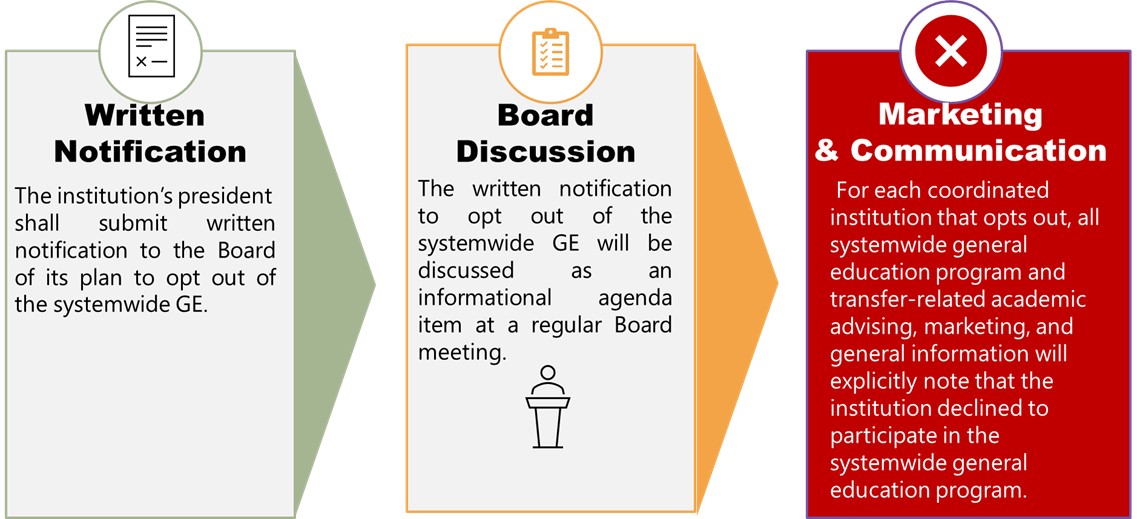
Link to Apply Kansas and Apply Kansas Site Coordinator Training Registration.

The All Star High School program, launched in 2022, extends the Apply Kansas mission to enhance college access by guiding students through the application process. Students in these schools receive support in completing admissions applications, seeking financial aid, and celebrating all postsecondary paths. This ongoing series of events, sustained year after year, cultivates a college-going atmosphere throughout the entire school community.
2024 All Star High school recognition
2024 Kansas All Star High Schools
| High School | City | High School | City | High School | City |
| Altoona-Midway High School | Buffalo | Greenbush Virtual Academy | Lawrence | Ottawa High School | Ottawa |
| Andover Central High School | Andover | Halstead High School | Halstead | Paola High School | Paola |
| Andover High School | Andover | Hanover High School | Hanover | Parsons High School | Parsons |
| Ashland High School | Ashland | Hayden Catholic High School | Topeka | Peabody-Burns High School | Peabody |
| Atchison High School | Atchison | Hiawatha High School | Hiawatha | Pike Valley High School | Scandia |
| Augusta High School | Augusta | Highland Park High School | Topeka | Pratt High School | Pratt |
| Baldwin High School | Baldwin City | Hodgeman County High School | Jetmore | Quinter High School | Quinter |
| Basehor-Linwood High School | Basehor | Hoisington HIgh School | Hoisington | Rolla Jr/Sr High School | Rolla |
| Beloit Jr./Sr. High School | Beloit | Hope High School | Hope | Rossville Jr/Sr High School | Rossville |
| Blue Valley High School (Randolph) | Randolph | Hoxie High School | Hoxie | Royal Valley High School | Hoyt |
| Bucklin High School | Bucklin | Hugoton High School | Hugoton | Russell High School | Russell |
| Burlingame Jr./Sr. High | Burlingame | Humboldt High School | Humboldt | Sabetha High School | Sabetha |
| Burlington High School | Burlington | Jackson Heights High School | Holton | Salina South HIgh School | Salina |
| Campus High School | Wichita | JC Harmon High School | Kansas City | Satanta Jr/Sr High School | Satanta |
| Caney Valley High School | Caney | Kinsley Junior Senior High School | Kinsley | Scott Community High School | Scott City |
| Cedar Vale High School | Cedar Vale | Kiowa County High School | Greensburg | Sedan High School | Sedan |
| Chanute High School | Chanute | La Crosse High School | La Crosse | Sedgwick High School | Sedgwick |
| Chase County Jr/Sr High School | Cottonwood Falls | Labette County High School | Altamont | Shawnee Heights High School | Tecumseh |
| Cheney High School | Cheney | Lakin High School | Lakin | Shawnee Mission North High School | Overland Park |
| Circle High School | Towanda | Lebo High School | Lebo | Shawnee Mission Northwest High School | Shawnee |
| Clay Center Community High School | Clay Center | Liberal High School | Liberal | Shawnee Mission South High School | Overland Park |
| Clifton-Clyde High School | Clyde | Linn High School | Linn | Shawnee Mission West High School | Overland Park |
| Colby High School | Colby | Lyndon High School | Lyndon | Skyline High School | Pratt |
| Complete High School | Maize | Macksville High School | Macksville | Smoky Valley High School | Lindsborg |
| Concordia Jr Sr High School | Concordia | Maize High School | Maize | Southeast High School (Cherokee) | Cherokee |
| Council Grove High School | Council Grove | Maize South High School | Wichita | St. John High School | St. John |
| Deerfield High School | Deerfield | Marais des Cygnes Valley | Melvern | St. Marys Jr Sr High School | St. Marys |
| Dighton High School | Dighton | McPherson High School | McPherson | Stafford High School | Stafford |
| Dodge City High School | Dodge City | Meade High School | Meade | Sterling High School | Sterling |
| Doniphan West High School | Highland | MInneapolis High School | Minneapolis | Sublette High School | Sublette |
| Douglass High School | Douglass | Minneola High School | Minneola | Sumner Academy of Arts and Sciences | Kansas City |
| Eisenhower High School | Goddard | Mission Valley Jr/Sr High School | Eskridge | Syracuse High School | Syracuse |
| El Dorado High School | El Dorado | Moscow High School | Moscow | Thomas More Prep-Marian High School | Hays |
| Ellinwood High School | Ellinwood | Mulvane High School | Mulvane | Topeka High School | Topeka |
| Ellis High School | Ellis | Nemaha Central High School | Seneca | Topeka West High School | Topeka |
| Ell-Saline High School | Brookville | Neodesha High School | Neodesha | Ulysses High School | Ulysses |
| Emporia High School | Emporia | Ness City High School | Ness City | Valley Center High School | Valley Center |
| Erie High School | Erie | Newton High School | Newton | Victoria High School | Victoria |
| Eureka Jr Sr High School | Eureka | Northeast High School | Arma | Wakefield High School | Wakefield |
| FL Schlagle High School | Kansas City | Northeast Magnet High School | Bel Aire | Washburn Rural High School | Topeka |
| Flinthills High School | Rosalia | Norwich High School | Norwich | Washington High School | Kansas City |
| Fort Scott High School | Fort Scott | Olathe East High School | Olathe | Waverly High School | Waverly |
| Fredonia High School | Fredonia | Olathe North High School | Olathe | White City High School | White City |
| Frontenac High School | Frontenac | Olathe Northwest High School | Olathe | Wichita County Jr/Sr High School | Leoti |
| Garden City High School | Garden City | Olathe South High School | Olathe | Wichita High School East | Wichita |
| Gardner Edgerton High School | Gardner | Olathe West High School | Olathe | Wichita High School Heights | Wichita |
| Goodland High School | Goodland | Osage City High School | Osage City | Wichita High School South | Wichita |
| Great Bend High School | Great Bend | Oskaloosa High School | Oskaloosa | Wichita High School West | Wichita |
| Greeley County High School | Tribune | Oswego Jr./Sr. High School | Oswego | Wichita North High School | Wichita |
| Wyandotte High School | Kansas City |
Becoming an All Star High School is EASY!
1. Host an Apply Kansas Event
Register as an Apply Kansas School
Host your Application Event
2. Submit your Apply Kansas Summary Data (due annually December 1st)
3. Sponsor or collaborate on a FAFSA Completion Event (typically between Oct-Feb)
Plan an event where students & parents can start on the FAFSA application together
Event should provide support to answer specific, confidential questions for families. Financial Aid officers and Admissions representatives from local institutions are often good resources and willing to come help.
FAFSA events can be held at the high school, but can also be held at higher education institutions or other community locations if you are joining together with other high schools.
Be aware of shift work, first generation, undocumented students and other underserved populations. Try to create an event at times and in locations that meets the needs of your underserved community members.
If you host a FAFSA event in the fall, consider doing something again in Jan-Feb. Many students who would benefit most from the FAFSA aren't always ready to apply in the fall. Follow up encouragement and support in the new year might be just what some students need to finalize those postsecondary plans
4. Host a Senior Signing Day Event (around May 1)
This event should celebrate the decisions and different pathways for your seniors.
It can be as big or small as you want to make it. (Some schools make it actual signing event for all seniors and invite different colleges, and some incorporate announcing the plans of all seniors into their Honors and Awards ceremony. Creating a bulletin board, banner, poster activity, t-shirt day are all some of the many great ways you can celebrate your seniors' plans) See the link in the resources below.
Whatever you plan, consider how it will look for students planning to go to work or other placements. If you are announcing college placements, how will you announce the job placements? If you do a t-shirt day, will all students be able to participate? You might have to get creative with some of the non-traditional pathways.
Consider if you can share these pathways with your underclassmen. Can you hang the banner or bulletin board for the school community to see? Are underclassmen invited to your award ceremony. By celebrating every senior, you give all of your students an opportunity to consider a post-secondary path outside of what they already know.
5. Complete the All Star Survey (April 1st) from Mistie Knox to describe your three events
RESOURCES
College Signing Day National Resource Website
Google Doc with College Signing Day Photos & Ideas (add your ideas to share here!)
BANNER
Each All Star High School will receive a certificate and vinyl banner to display at school (photo 1). Each year after that, award winning schools will receive a certificate and star sticker to add to their banner, indicating multiple award winning years (photo 2).
Year #1: Banner

Year #2-5: Sticker
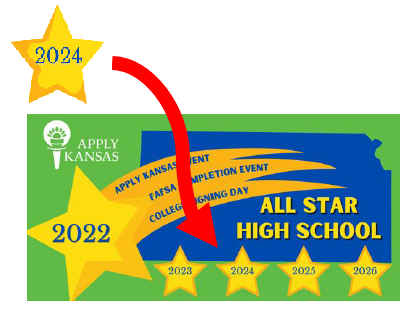
CONTACT
For more information:
Mistie Knox, Associate Director, Academic Affairs
Apply Kansas State Coordinator

